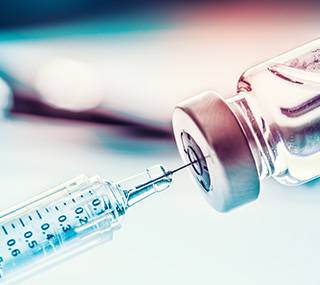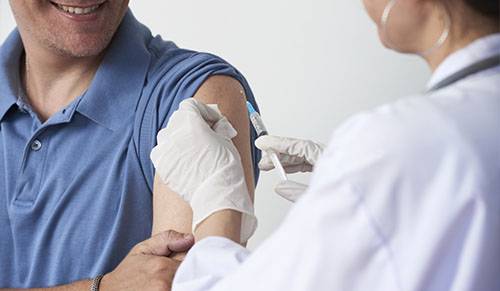Vaccines
What are vaccines?
Vaccines are made up of one or more active substances of biological origin called “vaccine antigens” derived from bacteria or viruses capable of stimulating antibody production by the immune system.Vaccines protect against viral diseases (viral vaccines), or bacterial diseases (bacterial vaccines). A disease like smallpox, responsible for 300 to 500 million deaths in the 20th Century, was eradicated worldwide in 1980 thanks to vaccination.
Vaccines are preventive medicines usually administered to healthy subjects and often to children, from the first months of their lives, followed by regular boosters in accordance with the different vaccination schedules (diphtheria, tetanus, polio, measles, mumps, rubella, etc.).
For the public health objective of combatting infectious diseases, in order to be effective, vaccination must be as extensive as possible in target population. This is referred to a vaccination coverage, meaning that, vaccination may concern many people.
Therefore, vaccination may have an individual benefit, by protecting each vaccinated person, but it may also have a collective benefit for certain diseases, by reducing the number of people likely to contribute to spread a disease and by protecting people who cannot be vaccinated.
There are several types of vaccines, the most common being :
They also make it possible to reduce the quantity of antigen per dose, i.e. reduce the number of doses required to provide good immunisation.
Attenuated live vaccines (such as measles-mumps-rubella) does not need any adjuvant: they are sufficiently immunogenic.
Aluminium salts are among the most commonly used adjuvants worldwide with over 90 of use, and hundreds of millions of injected doses.
Novel adjuvants for novel vaccines have been developed, particularly emulsions and phospholipids. Others are under development.
Calcium phosphate-based adjuvants were developed in the 1970s, but were later abandoned. Data in the literature did not demonstrate either superior tolerance or superior efficacy.
Approximately 350 batches of Northern Hemisphere seasonal flu vaccines are released each year over a period of three months to cover the start of the vaccination campaign from late September.
Vaccines are sensitive medicines: their production involves starting materials of biological origin, as well as a complex process, subject to variability. Their marketing conditions are enhanced through a release process by a national authority in addition to the quality control generally performed by the manufacturer.
ANSM’s release control for each batch, alongside the quality control performed by the manufacturers, provides an additionnal guarantee of vaccine safety.
Vaccines are composed of active substances of biological origin. Some production systems involve live organisms (culture on eggs, on cells). Manufacturing processes are often lengthy and complex. Low active substance dosages or low frequency of use also increase the benefit of batch-by-batch monitoring under the responsibility of an authority independent from the manufacturer to ensure quality and ensure production remains regular over time.
ANSM’s laboratories are the leading vaccine release centre in Europe. The Agency releases almost 40% of vaccine batches used in Europe and approximately 50% of vaccine doses administered in France every year. ANSM is also deeply involved in United Nations vaccine programmes (batch release on behalf of the World Health Organization).
There are several types of vaccines, the most common being :
- Attenuated live vaccines consisting of live microorganisms (virus, bacteria) which have been modified to lose their infectious potential, while retaining their ability to induce protection in a vaccinated person;
- Inactivated vaccines and subunit vaccines which do not contain live infectious agents. They may contain either fragments of the infectious agent (such as its wall or its toxin), or the whole infectious agent, which is inactivated.
- More recently, messenger RNA vaccines have been developed. These consist of a molecule known as ribonucleic acid, manufactured in a laboratory from viral RNA, which enables synthesis of a viral protein in our cells. This protein induces protection in the vaccinated person.
- Another category is viral vector vaccines, which consist of a safe virus to which the gene of a protein of the target virus has been added. This gene enables viral protein production which will induce protection in the vaccinated individual.
What is the role of adjuvants?
Adjuvants are added in the manufacture of inactivated and synthetic vaccines to enhance the immune response to the microbial antigen in the vaccine. They help trigger a warning signal to activate, the immune system and ensure the vaccine's efficacy.They also make it possible to reduce the quantity of antigen per dose, i.e. reduce the number of doses required to provide good immunisation.
Attenuated live vaccines (such as measles-mumps-rubella) does not need any adjuvant: they are sufficiently immunogenic.
Main adjuvants
Based on all available date, experts consider aluminium salts as the preferred adjuvant for enhancing the efficacy of vaccines against pathogens that require high antibody levels for prevention.Aluminium salts are among the most commonly used adjuvants worldwide with over 90 of use, and hundreds of millions of injected doses.
Novel adjuvants for novel vaccines have been developed, particularly emulsions and phospholipids. Others are under development.
Calcium phosphate-based adjuvants were developed in the 1970s, but were later abandoned. Data in the literature did not demonstrate either superior tolerance or superior efficacy.
Batch release: two-pronged specific control
Every year in France, approximately 25 million vaccine doses are sold: around twenty vaccines without adjuvants for children and adults (approximately 13.3 million doses administered per year, primarily the flu vaccines), and around thirty vaccines with adjuvants (combined vaccines) for children and adults (approximately 12.4 million doses per year) [source: sales in 2016].Approximately 350 batches of Northern Hemisphere seasonal flu vaccines are released each year over a period of three months to cover the start of the vaccination campaign from late September.
Vaccines are sensitive medicines: their production involves starting materials of biological origin, as well as a complex process, subject to variability. Their marketing conditions are enhanced through a release process by a national authority in addition to the quality control generally performed by the manufacturer.
ANSM’s release control for each batch, alongside the quality control performed by the manufacturers, provides an additionnal guarantee of vaccine safety.
Guarantee of quality and independence of controls
The concept of batch-by-batch release by an independent authority, conducted in parallel with the manufacturer, is an additional guarantee of long-term control over of the pharmaceutical safety and quality of vaccines. The maximum regulatory time allowed for the release of a vaccine batch is 60 days (as set by the European Union).Vaccines are composed of active substances of biological origin. Some production systems involve live organisms (culture on eggs, on cells). Manufacturing processes are often lengthy and complex. Low active substance dosages or low frequency of use also increase the benefit of batch-by-batch monitoring under the responsibility of an authority independent from the manufacturer to ensure quality and ensure production remains regular over time.
ANSM’s laboratories are the leading vaccine release centre in Europe. The Agency releases almost 40% of vaccine batches used in Europe and approximately 50% of vaccine doses administered in France every year. ANSM is also deeply involved in United Nations vaccine programmes (batch release on behalf of the World Health Organization).
Vaccine batch control in brief
Routine controls are performed on finished product samples as well as on production intermediates.They primarily consist of testing the following parameters:
- Identification;
- In vitro / in vivo activity;
- Stability;
- Microbiological safety;
- Physicochemistry;
- Product characterisation;
- Specific toxicity.
*A valence is the part of a vaccine providing protection against a single microorganism. A multivalent vaccine may provide protection against several microorganisms causing the same disease (such as the 13-valent pneumococcal vaccine) or against different diseases (such as the measles-mumps-rubella vaccine)
Viral vaccines (i.e. those protecting against viral infections)
The main controls are as follows:
- Titrations in cell culture for live attenuated vaccines (measles, mumps, rubella, yellow fever, attenuated polio vaccine);
- Radial immunodiffusion (influenza vaccines);
- In vitro activity tests primarily using the ELISA method (hepatitis B, hepatitis A, inactivated polio vaccine, rabies);
- Identity, purity and quantification tests (for mRNA vaccines).
The main controls are as follows:
- Bacterial culture (BCG);
- In vivo activity tests (Diphtheria, Tetanus, Acellular or Whole Cell Pertussis);
- In vitro toxicity, identification and production monitoring tests (Tetanus, Diphtheria, Pertussis);
- Physicochemical methods: polysaccharide quantification using chromatographic, colorimetric, nephelometric methods. Polysaccharide molecular size distribution using high-performance liquid chromatography.
Post-marketing vaccine surveillance
ANSM monitors the safety of vaccine use in general, particularly by monitoring adverse reaction reports (pharmacovigilance) and conducting pharmaco-epidemiological studies. We regularly inform healthcare professionals and the general public about the results of these monitoring activities.Key messages
Like all medicinal products, vaccines may cause adverse reactions. Most vaccine-related reactions are mild and short-lived. Serious adverse reactions are very rare, and, when they arise, are the subject of monitoring and detailed investigations.
Vaccines containing mandatory valences for children: an enhanced surveillance framework
This surveillance framework, coordinated by ANSM, involves proactively raising awareness among healthcare professionals and the general public on adverse reaction reporting. The methods proposed by ANSM for optimised enhanced surveillance include:- Assistance with report input specifically for vaccines on the reporting portal in addition to indicator and alert threshold tracking based on the reports compiled via the portal;
- Implementation of statistical signal detection on the French national pharmacovigilance database (BNPV);
- Implementation of tracking indicators of cases of adverse reactions recorded in the French national pharmacovigilance database (BNPV) tailored to each of the vaccines in question.
If necessary, additional pharmaco-epidemiological studies may be conducted.
Vaccine availability
Vaccines are considered as medicines of major therapeutic value (referred to as MITM). For this reason, ANSM is involved in managing shortages and supply tensions related to these medicines, working closely with all of the pharmaceutical companies concerned.
There are multiple possible causes of vaccine supply tensions and stock shortages: substantial increase in global demand, problems arising during productions liable to impact vaccines before or after they are supplied to the market.
The vaccine manufacturing process is complex and longer (from 6 to 22 months) than for other medicines. This explains why the process to restock products may be lengthy and gradual.
The vaccine manufacturing process is complex and longer (from 6 to 22 months) than for other medicines. This explains why the process to restock products may be lengthy and gradual.
To find out more, you can also refer to:
Other information
- Infovac
Vaccination information platform aimed at healthcare professionals - Mesvaccins.net
Interactive website reporting the latest developments on vaccines, from vaccine composition to information for travellers - Institut Pasteur
Travel preparation page

